WTF is going on in the US?
I know that many of us are unnerved by what we’re seeing in the world around us.
Every hundred years or so, we’re faced with the same lesson, and we’ll continue to do so until we answer it correctly, by learning from our mistakes, by listening to the oppressed, and by blazing a more courageous path forward than we did the last time.
Here are a few notes about how we handled things the last few times:
Over 100 years of Civil Rights work
In the 1860s (about 100 years before the Civil Rights Movement that we remember today), there was a civil rights movement for all of the people who had been freed from slavery, but hadn’t been allowed to be citizens in their own right.
We did quite a few things to maintain the order that we were used to, rather than any semblance of justice.
Slavery, as a formal institution, was abolished during this era, but having free POC who didn’t have property or formal employment also meant that there was a means for exploitation.
If you’re not familiar with the Black Codes, Jim Crow Laws, or the Vagrancy laws, these were used to restrict the freedoms and movement of POC.
The Vagrancy laws are especially insidious. Essentially, vagrancy is the sin of being unemployed while Black. Sure, a handful of white folks were incarcerated under the same law, but we’re talking about 1 out of every 10 prisoners.
What did the charge of vagrancy warrant? Well, this is where for-profit prisons come from.
Vagrancy meant that one could be incarcerated, then leased out to companies or landowners for work at even less than they’d be spending to manage slave labor. What’s even more impressive? Instead of trying to get some sort of “lifetime value” from your dollars as an owner, when you’re leasing humans, you only have to aim for as much as you can get out of them for the day, because if they died from the labor or abuse, they’d be replaced tomorrow. Added bonus: if a leased vagrant ‘escaped’ the work detail, they had to be returned to the lessor when captured, would be affixed with a ball-and-chain, and would be forced to work for no compensation at all (which also incentivized those who leased vagrants to claim an escape was attempted). All gain, no risk (for the lessors).
The replacement of servitude for incarceration was a calculated maneuver by those who were used to getting their labor damn-near free.
And this is where our legacy of “free labor” or having to legally require businesses to pay people at least a minimum wage begins.
The Black Codes and Jim Crow Laws took a few more liberties as well – ensuring that one couldn’t work for anyone without their previous employer’s permission (remember that “previous employers” weren’t just bosses, but masters), restricting one’s ability to quit a job without forfeiting all of their earned income, being forced to live on-site of any employment (instead of being able to go home to your family at night or on weekends), the absence of weekends (except for a few rules about working certain jobs on Sundays), and the inability to ask for a living wage – if any wage at all were refused, one would be considered a ‘vagrant,’ making them eligible for hiring out at pennies of what a living wage would be.
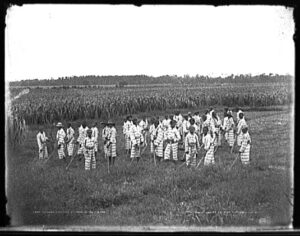
Juvenile forced workers, likely Louisiana
I’d caution against assuming that this only applied to adults. One of the most powerful effects of the Vagrancy law was what it made of the children. “Orphans” (or those who no longer had a guardian to care for them, because they were being farmed out as vagrants) were able to be incarcerated as “Juvenile” convicts, who were also wards of the state and farmed out to companies and landowners as labor. These children (as young as 5 or 6 years old) were kept “in the system” until they were of-age, which meant a very economical source of labor for ~15 years, if they caught them early.
The “End of Slavery” wasn’t anything resembling an end to slavery, we merely wrote different laws and made them cheaper to take advantage of.
If you’re wondering why companies have a difficult time paying a reasonable rate for labor, this is where those roots lie.
What about Veterans?
About 100 years ago, at the end of WWI, African-American Veterans returned home to a country that was hostile to their presence, especially as men who were valued for their service.
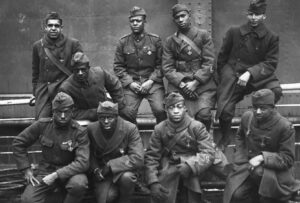
Members of the 369th Infantry Regiment, also known as the Harlem Hellfighters, who were awarded the coveted Croix de Guerre from the French government before heading home after World War I, 1919.
In 1919, the KKK (and anyone who sympathized with them) terrorized predominantly Black neighborhoods and those who returned home from “returning Democracy to the world” walking a little taller than they did when they left. For some, seeing people un-subjugated seems a lot like seeing people who are superior, but that really only happens for those who subjugate people in order to feel superior in the first place.
While white people celebrated burning down the homes and churches of their neighbors who fought for them in the first World War, Veterans returning home took up self-defense positions in their neighborhoods – similar to what they were trained to do in the military – to defend their homes from mobs of white people who would attack and burn them down.
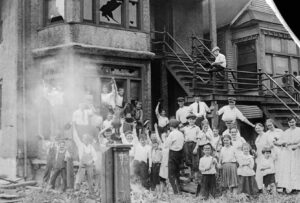
White children cheer outside an African-American residence that they set on fire in September, 1919.
This went on for months and was called the Red Summer, due to all of the deaths born at the expense of our Black brethren.
(Some of these folks are still alive… this isn’t ancient history, and they’re worth listening to.)
Doesn’t “Separate but Equal” mean something?
Yes. Yes, it does. But not what you may think.
Many of the race-centric laws enacted to account for the fact that we couldn’t incarcerate every POC, essentially made it legal to subject POC to many forms of sub-humane treatment.
The bus systems are only one example.
As rules went, busses had separate seating for blacks and whites (blacks in the back, whites up front), with somewhere in the middle being the transition zone… but whites were never restricted from sitting as far back on a bus as their numbers warranted (basically, whites never had to stand on a bus and could sit where they wanted, but blacks were restricted to certain seats, if they were available, and could never impose upon a white person’s space), so this gave way to whites taking up seats, leaving empty ones, since black folks weren’t allowed to sit next to them, and taking up all the seating on a bus, just because they could.
This also meant segregating schools and making sure that the budget for the black school was a fraction of what the white school had.
It meant separate dining rooms at restaurants, with drastically different service and food offerings across the partitions.
It meant separate water fountains, restrooms, waiting areas, train cars, housing options, pay rates, grocery options, everything… including separate justice systems.
What if they just built their own communities?
Only two years after the Red Summer, in 1921, there was a thriving community in Tulsa, OK, comprised of property, businesses, hospitals, schools, churches, financial districts, newspapers, a theatre, all owned by the African-American people who lived there. This community had built its own wealth and was a magnet for educated, successful POC who wanted to live in a healthy community – attorneys, doctors, teachers, chefs, entertainers, craftsmen. It was casually referred to as Black Wall Street.
Many people who have grown up in Tulsa have no idea this place ever existed, because Greenwood was destroyed in a single day, and those who destroyed it… wiped it clean from their own history books.
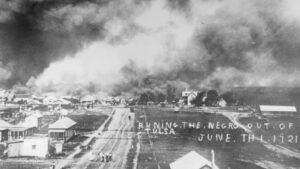
Greenwood, Tulsa, OK, 1919
An angry white mob killed hundreds of citizens, looted the stores and homes, the police and National Guard joined the mob, mounted machine guns and fired on the main street through the center of town, referring to citizens as “the enemy,” they even called in air support… planes flew in and dropped burning turpentine balls on the entire neighborhood, burning over 1,200 homes and 36 city blocks… leveled.
After destroying everything, including their hospital, the white-owned hospitals would not treat the injured, many of whom died from treatable injuries.
10,000 people were now homeless, jobless, and trapped in a hostile place. 10,000 people who were, up until that point, living peacefully, successfully, and justly in a community of their own making. 6,000 of these people were rounded up and put into internment camps for weeks afterward. Casualties were buried in unmarked graves. Not a single insurance claim was paid out. Not a single arrest made or fine levied against the perpetrators. As far as Tulsa was concerned, the place never existed, and nothing happened.
Except it did.
Which also made it abundantly clear that POC were not allowed to be successful or self-sufficient.
We shouldn’t be segregated anyway
Then we should talk about redlining.
The term “redlining” refers to the practice of establishing areas where POC are not eligible for bank loans, like neighborhoods where mortgages are only available for certain races, but it’s not restricted to loan practices.
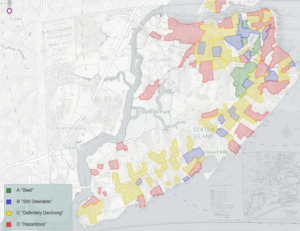
Redlining map
Redlining extends to things like insurance coverage, healthcare, policing, even grocery stores. Another way of using these ‘redlines’ against POC is to target these neighborhoods and charge more than one would in a non-redlined neighborhood for things like rent, groceries, insurance, healthcare, taxes, fines, childcare, education, interest rates, public works, etc.
What this does is segregate neighborhoods, industries, and economies, while ensuring that it’s simply more difficult, dangerous, and expensive to exist as a POC.
Restricting access and hoarding resources: the system isn’t broken, it’s working exactly as designed.
We’ve never been one country
If our aim is to be a single, autonomous county… it’s time that we became one country.
We may use the term “melting pot” from time to time, but if we only mean ‘it’s a nice garnish for our saltine-Americans’, we’re no such thing.
A country is only as just and free as the least of its citizens. By that measure, we’re still working our way out of an abysmal heritage of human trafficking, slavery, pseudo-slavery, abuse, and attempting to preserve that legacy.
Enough.
We’re still writing laws that decree a person’s gender or sexual orientation as a condition of personhood. We’re still writing laws that are only intended to be enforced among minority members of our communities. We’re still writing laws that call into question whether or not a rape can be considered consensual. We’re still writing laws that question whether or not a child can be considered an adult, because they were ‘intimidating’ to actual adults. We’re still writing laws that allow trained, armed adults to claim incompetence as peacekeepers, harming or even killing their “sworn to protect” patronage, while continuing to serve in the role in which they have already proven to be incompetent.
We created a “war on drugs” that, in practice, hasn’t reduced the availability or use of illegal drugs, but has given license to police to harass minorities at will (stop-and-frisk along with other searches without cause), planting drugs has become common place, and the disproportionate arrest rates and sentencing for the same offenses is staggering… we’re not even trying to hide the fact that POC are targeted by these laws.
We’ve got hundreds of years’ worth of laws – legally, on the books, allowed to enforce, laws – that target POC and other minorities in our country (or are disproportionately enforced) that need revision or revocation, which is 100% within our reach.
Until our laws can simply be stated as HUMANS have this right, and HUMANS are afforded this freedom, we’re not there yet.
Is there still hope?
You’re damn right there is.
It will take a re-focusing, though, and approaching our legacy with our eyes wide open.
Right now, it’s unsettling how focused we are on “order” instead of justice, on “compliance” instead of justice, on “obedience” instead of justice… it’s about time that we spent even half of that energy focusing on justice instead of order, at any cost.
This has been our legacy to-date.
Where we go from here is entirely up to us.
XOXO,

In case you were curious: there is no statute of limitation on crimes against humanity. FYI.
Further Reading
Stamped from the Beginning: The Definitive History of Racist Ideas in America, Ibram X. Kendi
The New Jim Crow: Mass Incarceration in the Age of Colorblindness, Michelle Alexander
The Color of Law: A Forgotten History of How Our Government Segregated America, Richard Rothstein
Black Reconstruction in America, W.E.B. Du Bois
Forever Free: The Story of Emancipation and Reconstruction, Eric Foner
Slavery by Another Name, Douglas Blackmon
One Dies, Get Another: Convict Leasing in the American South, 1866-1928, Matthew J. Mancini
Interactive Redlining Map, NPR, Camila Domonoske
The Blue Ribbon Panel on Transparency, Accountability, and Fairness in Law Enforcement, City and County of San Francisco, SFBlueRibbonPanel.com
Recommendations for Reform: Restoring Trust Between the Chicago Police and the Communities They Serve, Police Accountability Task Force
Supporting Policy Change and Education
Boston University Center for Antiracist Research
Self-Examination & Moving Forward
White Fragility: Why It’s So Hard for White People to Talk About Racism, Robin DiAngelo
So You Want to Talk About Race, Ijeoma Oluo
How to Be an Antiracist, Ibram X. Kendi
Workbook for: How to Be an Antiracist, Growth Hack Books (a companion book for How to Be an Antiracist, Ibram X. Kendi)
Antiracist Baby, Ibram X. Kendi & Ashley Lukashevsky (Illustrator)